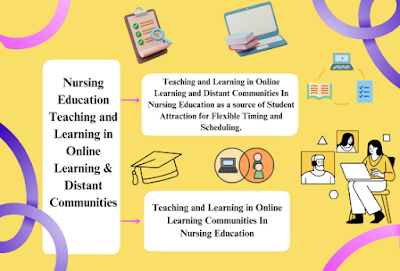The Teaching and Learning in Online Learning and Distant Education Communities In Nursing Education. In the rapidly changing landscape of higher education, the question is no longer whether courses should be delivered online, but rather if traditional face-to-face instruction is still necessary.
The Teaching and Learning in Online Learning and Distant Education Communities In Nursing Education
With over 75% of colleges and universities now offering online course options, and this figure rising to over 90% among two-year institutions (Parker, Lenhart, & Moore, 2011), online learning has become a standard rather than an exception.
In online nursing education, teaching and learning are characterized by the use of technology and flexible delivery methods. Online learning, including distance learning, provides flexibility and access to advanced educational resources and influences nursing students’ acquisition of clinical and theoretical skills. Blended learning models that combine online and traditional instruction are often more effective for acquiring knowledge and developing skills.
The Shift to Online Learning
Online education has evolved beyond its initial association with distance learning. Today, it serves not only remote students but also those attending residential campuses. The shift is driven by several factors, including environmental concerns. Online learning significantly reduces energy consumption and carbon emissions, making it a “green” choice with a 90% reduction in emissions due to the absence of commuting (Roy, Potter, Yarrow, & Smith, 2005).
Embracing Flexibility: A Student-Centric Approach
The appeal of online learning lies in its flexibility. As of 2013, over 7.1 million college students—33.5% of the student population—had enrolled in at least one online course (Allen & Seaman, 2014). Academic leaders recognize the importance of online education for institutional success, with 66% agreeing it is crucial for their institution’s future and 77% believing it achieves learning outcomes on par with or exceeding traditional methods.
Global Expansion and Innovation
English-speaking countries have long led the charge in global higher education, leveraging advances in communication and information technology to deliver education across borders (Marginson, 2014). This global approach has made higher education more accessible, allowing students worldwide to engage in Massive Open Online Courses (MOOCs) and other online offerings.
On-Campus and Remote Learning Integration
Today, online courses attract both on-campus and remote students. For on-campus students, online learning offers the convenience of accessing course materials and completing assignments from their dorm rooms, thus catering to their schedules and preferences.
The rise of online learning is fueled by students’ demand for immediate access to educational resources and flexible scheduling. With most students using laptops, smartphones, or tablets for their studies (Parker et al., 2011), and younger students growing up in a digital era, the integration of technology in learning is both natural and expected.
The Role of Online Learning in Nursing Education
In nursing education, online learning has become particularly significant. The increasing number of online programs caters to students pursuing BSN completion and graduate degrees. Continuing education providers also use online platforms to reach healthcare professionals who value the flexibility of remote learning.
Nursing faculty are increasingly incorporating online elements into traditionally in-person courses, creating blended or hybrid learning experiences. One popular model is the “flipped classroom,” where students engage with online materials such as readings, lectures, and videos before attending class. This approach allows classroom time to focus on interactive and applied learning (Critz & Knight, 2013; Barra, 2014).
Building a Global Learning Community
Online education facilitates the formation of an international nursing community, enabling nurses worldwide to access diverse educational resources. This global reach helps address the nursing shortage and improves the quality of education through enhanced technology and flexible learning options.
Challenges and Considerations
Despite its benefits, teaching in online learning communities (OLCs) presents challenges for many nurse educators. Successful online education requires both faculty and students to adapt to new roles and responsibilities within the learning process. Additionally, institutions must address various organizational issues to effectively implement online education.
Conclusion
Online learning is transforming nursing education by offering flexible scheduling and broader access to educational resources. As this mode of learning continues to evolve, it will increasingly meet the diverse needs of students and professionals, shaping the future of education in the nursing field and beyond.
Read More:
https://nurseseducator.com/didactic-and-dialectic-teaching-rationale-for-team-based-learning/
https://nurseseducator.com/high-fidelity-simulation-use-in-nursing-education/
First NCLEX Exam Center In Pakistan From Lahore (Mall of Lahore) to the Global Nursing
Categories of Journals: W, X, Y and Z Category Journal In Nursing Education
AI in Healthcare Content Creation: A Double-Edged Sword and Scary
Social Links:
https://www.facebook.com/nurseseducator/
https://www.instagram.com/nurseseducator/
https://www.pinterest.com/NursesEducator/
https://www.linkedin.com/in/nurseseducator/
https://www.researchgate.net/profile/Afza-Lal-Din
https://scholar.google.com/citations?hl=en&user=F0XY9vQAAAAJ

Очень трендовые события модного мира.
Абсолютно все эвенты мировых подуимов.
Модные дома, лейблы, высокая мода.
Приятное место для трендовых хайпбистов.
https://hypebeasts.ru/stuff/2024-08-18-demna-gvasaliya-ikona-sovremennoy-mody/